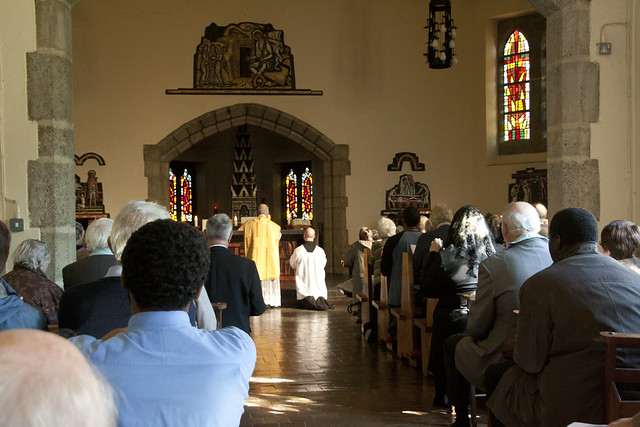Someone once told me that a priest (or possibly a bishop, I can't remember) declared that the implementation of the Novus Ordo would result in a Mass attendance comprised of women and children.
On a purely subjective level, I have noticed that there seems to be a much more balanced attendance at the Extraordinary Form Mass than at the Ordinary Form, and far more men at the former than at the latter...
Now there are many more options in the Ordinary Form - and I'm rather interested if it is the ad orientem worship which causes the difference, or the use of Latin, or just the fact that the usus antiquior hasn't been denuded of all the extras, such as the preparatory prayers, and that there aren't any "options."
The polls are in the sidebar - do go across and vote. I'm interested in your preferences, not what you actually attend.

Cardinal Heenan, it was.
ReplyDeleteMac, it was the late Cardinal Heenan who said that.
ReplyDeleteI would hope that the reason why 'men' attend the TLM is that they prefer a liturgy with full meaning and substance....I don't mean to be dismissive of the OF but it is (to me) a lighter form.
I too would like to know the actual reason.
Oh, please Richard. Back in the day the men liked the Latin Mass because on a Sunday if you went to low mass you were in and out of there in 35 minutes, in plenty of time to go home and not miss any Sunday football.
ReplyDeleteSometimes I'd wish I'd been a sociologist or something and had the skills (and time and funding) to come up with some proper demographics on this question. I'd like to know whether it's true of course, and how it breaks down by age and marital status. I've attended the EF in two different cities (both regular, every-Sunday parishes and over a period of at least 10 weeks) and FWIW I didn't notice any particular gender tilt.
ReplyDeleteAnd anyway, the "feminization" of religion is an old story dating back to the Enlightenment. So there could be some interesting historical context for any sort of gender difference we find now.
It's kind of ironic how often the 'liberals' in the Church say that all the vestments and rituals are off-putting to men when one see congregations of EF Masses which have far more men than at OF Masses. Maybe it's because men are sick of the liturgical dancing and the clappy-happy songs, and that's just as the most superficial level. As a woman, I'm pretty wary of any priest who likes these things.
ReplyDeleteGem....a great stereotypical picture..but not correct. I was there (sadly).
ReplyDeleteGaaaaargh! (strangled cry). How many times does one have to go on countering this false memory - because that's what it is - that the EF Mass was run through at breakneck speed.
ReplyDeleteI grew up with it. A weekday low Mass might be over in 20 minutes, (no re-reading of Gospel and Epistle in the vernacular, no homily, no collection, few communicants).
The Sunday Mass lasted at least 40 minutes - my experience of many parishes. There were only two readings in the vernacular, no bidding prayers, no stoppage in the priest's celebration for the march up the nave with the presentation of gifts and collection, no dedicated silences - no need - no interruption for the sign of peace, no EMHCs, therefore no separate distribution of Holy Communion on the sanctuary and no communicating of the Precious Blood.
It's the extraneous stuff which has added to the length of the Mass, not the celebration of Mass itself.
By the way, there were no Sunday professional football matches in the UK in those days as there was no Sunday opening of stores and supermarkets.
Just from observation alone the gender difference is striking in the OF, much as it pains me to say it. Most of the chattering before and immediately after Mass is generated by women. At an OF Missa Cantata, the louder the organ voluntary is played, the louder the conversations.
And, yes, it was the prescient John Carmel, Card. Heenan who made the observation after his first experience of the new Mass at the Vatican.
As one old enough to remember, may I just point out that what Gem says perhaps has a large dose of truth in it. I remember attending a low mass at 9a.m.on Sundays which was almost invariably over by 9.35a.m.. The additional reading, the Bidding Prayers and the involvement of lay people going up to do the readings together with the need of the priest to both "engage" with the congregation and select from various options have all contributed to the lengthening of the time mass takes. And...I almost forgot! The priest never sat down at a low mass!
ReplyDeleteAs a man- one with a fairly short attention span- I prefer things to be straightforward and, in whichever form, I am happiest when the black is said and the red is done. (If it wasn't adding sacrilege to murder I'd cheerfully strangle any priest given to throwing in ad libs!)
The source for the quotation with which I am familiar is 'A Bitter Trial' the correspondence between Evelyn Waugh and Cardinal Heenan about the liturgical changes, with some associated material.
ReplyDeleteWell worth reading.
Given that Cardinal Heenan was making a prediction that came true, perhaps his reasons carry more weight than Gem's...
Being an MC at my FSSP parish and having spoken with MC's from all over the US, we agree that the Tridentine seems more manly and the NO seems too wishy-washy; there is hardly any substance to it, opposed to the rock-solid and unmistakeable Latin tongue.
ReplyDeleteCompletely true. All it needs is a look around.
ReplyDelete